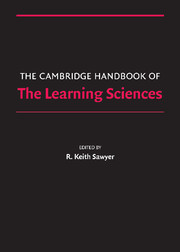Book contents
- Frontmatter
- Contents
- Preface
- Contributors
- 1 Introduction
- PART I FOUNDATIONS
- PART II METHODOLOGIES
- 8 Learner-Centered Design
- 9 The Evolution of Design Studies as Methodology
- 10 Design-Based Research
- 11 Guiding Inquiry-Based Math Learning
- 12 Analyzing Collaborative Discourse
- 13 Assessing for Deep Understanding
- PART III THE NATURE OF KNOWLEDGE
- PART IV MAKING KNOWLEDGE VISIBLE
- PART V LEARNING TOGETHER
- PART VI LEARNING ENVIRONMENTS
- Afterword: After How Comes What
- Epilogue: The Fundamental Issue in the Learning Sciences
- Author Index
- Subject Index
- References
9 - The Evolution of Design Studies as Methodology
Published online by Cambridge University Press: 05 June 2012
- Frontmatter
- Contents
- Preface
- Contributors
- 1 Introduction
- PART I FOUNDATIONS
- PART II METHODOLOGIES
- 8 Learner-Centered Design
- 9 The Evolution of Design Studies as Methodology
- 10 Design-Based Research
- 11 Guiding Inquiry-Based Math Learning
- 12 Analyzing Collaborative Discourse
- 13 Assessing for Deep Understanding
- PART III THE NATURE OF KNOWLEDGE
- PART IV MAKING KNOWLEDGE VISIBLE
- PART V LEARNING TOGETHER
- PART VI LEARNING ENVIRONMENTS
- Afterword: After How Comes What
- Epilogue: The Fundamental Issue in the Learning Sciences
- Author Index
- Subject Index
- References
Summary
In the NRC report, Scientific Research in Education (Shavelson & Towne, 2002), three broad types of research were discussed: trends, causal effects, and mechanism. Mechanism was described as research that answers the question, “how or why is it happening”; the authors described “design experiments” as an “analytic approach for examining mechanism that begins with theoretical ideas that are tested through the design, implementation, and systematic study of educational tools (curriculum, teaching methods, computer applets) that embody the initial conjectured mechanism” (p. 120). The Committee identified two products of such work as “theory-driven process of designing” and “data-driven process of refining [instructional strategies]” (p. 121). Both of these products can be viewed as related to a class of research known as design studies, the focus of this chapter.
Researchers across the country have recognized the need to strengthen the “instructional core” (Elmore, 1996) and to identify effective “instructional regimes” (Cohen, Raudenbush, & Ball 2003) as critical to the improvement of education. Likewise, Lagemann (2002) focused on the need for more research that produces useable classroom guidance. This review synthesizes the current progress of the methodology and identifies areas for future development.
Design studies are defined as “entailing both ‘engineering’ particular forms of learning and systematically studying those forms of learning with the context defined by the means of supporting them. This designed context is subject to test and revision. Successive iterations that result play a role similar to systematic variation in experiment” (Cobb et al., 2003, p. 9).
- Type
- Chapter
- Information
- The Cambridge Handbook of the Learning Sciences , pp. 135 - 152Publisher: Cambridge University PressPrint publication year: 2005
References
- 27
- Cited by



